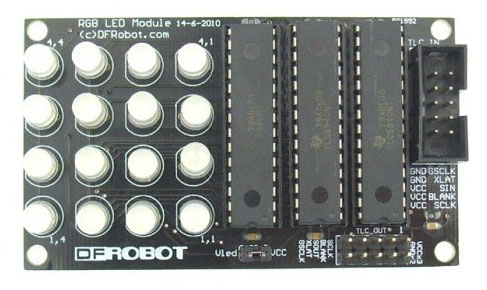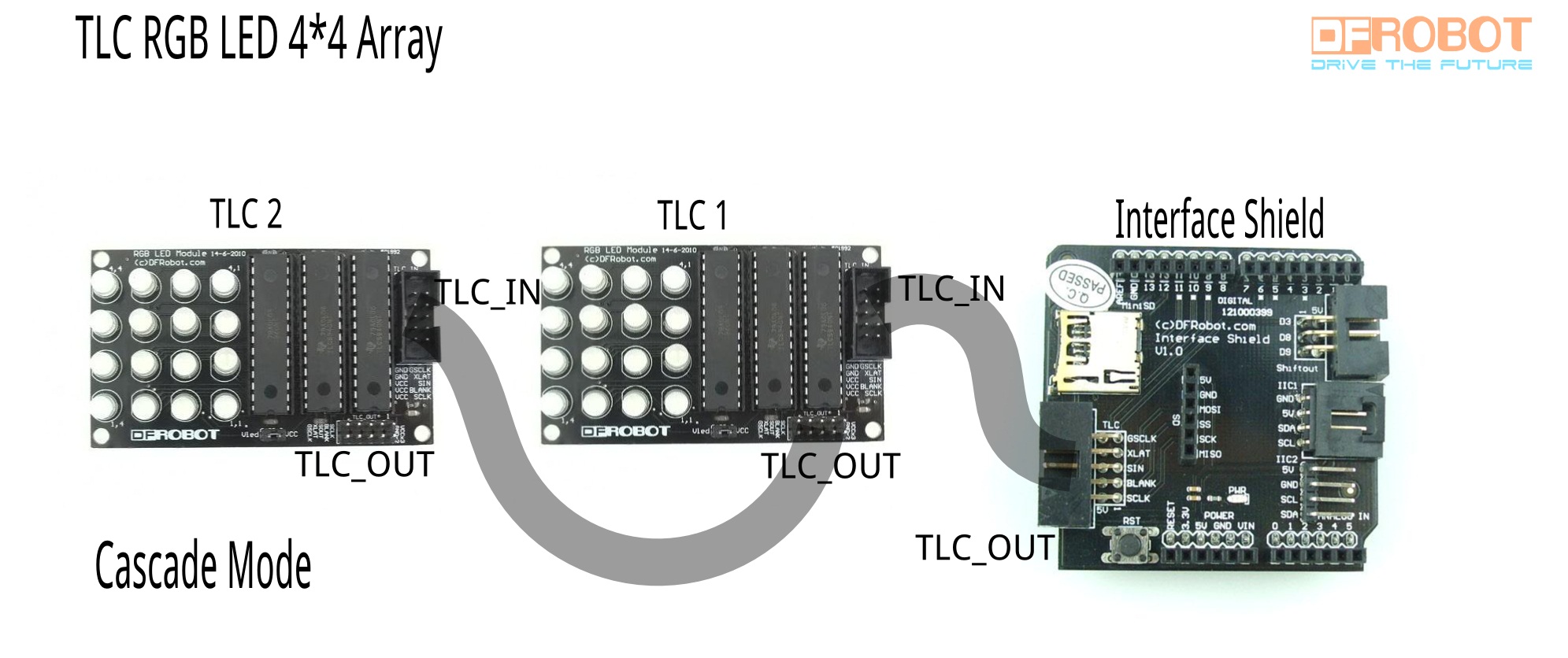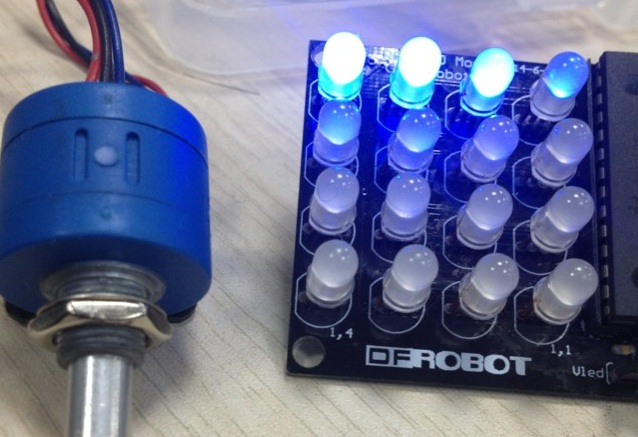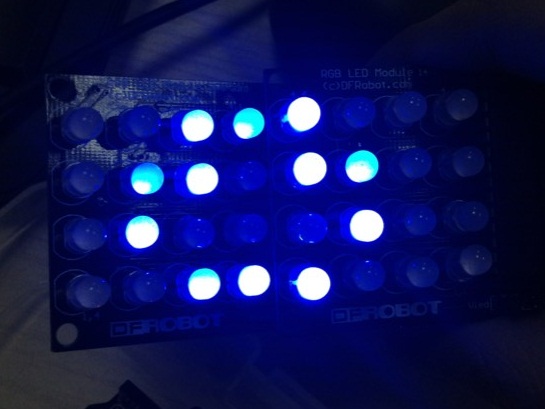RGB_LED_Module_Kit_全彩LED套件_兼容Arduino_SKU_DFR0124_ - jimaobian/DFRobotWikiCn GitHub Wiki

概述
4x4 RGB LED模块是一款能够制作不错灯光效果的互动产品。通过对模块的指令控制,能够实现对RGB全彩LED模块上的16个灯的颜色进行任意的切换变化。 模块使用3只TI公司的TLC5940NT PWM LED驱动芯片控制,每只芯片控制LED一种1颜色,通过程序控制每只芯片每个引脚PWM的占空比,即可实现4x4全彩点阵显示。推荐与Interface shield和IDC10连接线一起使用,可以直接与Arduino控制器连接,并且实现多个模组的驱动,搭建更大的灯光效果展示平台。 注意事项:全彩LED模块套件的插针电子元器件没有固定在PCB板上,故用户可以根据使用的需要自己焊接到电路板上,也可以使用散件直插在面包板上进行测试。另外,如果项目中不需要RGB的灯排布像PCB上那么精密,可以通过RGB灯的针脚接线的方式连接到PCB电路板的驱动孔上,从而实现一个自制的全彩灯光展示平台。
技术规格
- 模块供电电压:DC 5v
- RGB全彩LED同步驱动数量:16
- RGB LED类型:共阳
- 串行数据接口:5路数字信号驱动
- 可以与Interface shield使用Arduino直接驱动
- Arduino驱动引脚使用:
- 数字口D13(SCK) TLC5940 SCLK引脚
- 数字口D10(SS) TLC5940 BLANK引脚
- 数字口D11(MOSI) TLC5940 SIN引脚
- 数字口D9(数字口) TLC5940 XLAT引脚
- 数字口D3(数字口) TLC5940 GSCLK引脚
- 尺寸:78x45x12mm
连线图

用户指导
硬件准备
- 如果你有模拟接口 ,只需插在IDC2x5电缆插口。请参阅连接图
- 否则,请参阅基本的引脚设置:
------------ ---u----
ARDUINO 13|-> SCLK (pin 25) OUT1 |1 28| OUT channel 0
12| OUT2 |2 27|-> GND (VPRG)
11|-> SIN (pin 26) OUT3 |3 26|-> SIN (pin 11)
10|-> BLANK (pin 23) OUT4 |4 25|-> SCLK (pin 13)
9|-> XLAT (pin 24) . |5 24|-> XLAT (pin 9)
8| . |6 23|-> BLANK (pin 10)
7| . |7 22|-> GND
6| . |8 21|-> VCC (+5V)
5| . |9 20|-> 2K Resistor -> GND
4| . |10 19|-> +5V (DCPRG)
3|-> GSCLK (pin 18) . |11 18|-> GSCLK (pin 3)
2| . |12 17|-> SOUT
1| . |13 16|-> XERR
0| OUT14|14 15| OUT channel 15
------------ --------
- If you are daisy-chaining more than one TLC, connect the SOUT of the first TLC to the SIN of the next.All the other pins should just be connected together:
BLANK on Arduino -> BLANK of TLC1 -> BLANK of TLC2 -> ... <br>
XLAT on Arduino -> XLAT of TLC1 -> XLAT of TLC2 -> ...
- The one exception is that each TLC needs it's own resistor between pin 20 and GND.This library uses the PWM output ability of digital pins 3, 9, 10, and 11. Do not use analogWrite(...) on these pins.
软件准备
- 下载Arduino库文件。它包括几个头文件,最根本的是“Tlc5940.h”和“tlc_config.h”。第一个包含最基本的功能来控制LED阵列,第二个是变量声明。
示例代码
- 符号:
- 更改定义不变NUM_TLCS(在该文件中:“tlc_config.h”库中的文件夹incuded:“TLC5940”)的值从3到6(如果你想级联两个LED模块),9(如果你想级联三LED模块)...
- 通道的顺序确定由薄层单片机的顺序。 channnel0-15是16第一薄层单片机控制的红色发光二极管。通道16-3116个绿色LED,通道32-4716个蓝色发光二极管。一个RGB模块有3薄层微控制器,如果你想使用两个RGB LED模块,通道48-63第二个模块16个红色LED,等等。功能:Tlc.set(通道,亮度)。这是打开一个特定的LED功能。
- 让我们来看看样品1。
示例1是一个可控的LED颜色调整和衰落的演示。它使用库“tlc_fades.h”。 如果你有一个电位器,它会更好。否则,你可以连接模拟端口0到5V或地面观察其变化。替代参数“TLC_FADE_BUFFER_LENGTH”头文件tlc_fades.h“40。
/*
Description: Fades a line down the channels, with max value and duration based on
the voltage of analog pin 0.
See the BasicUse example for hardware setup.
This test demo is bases on the example "fades" and it should include head file "tlc_fades.h". ( Written by Alex Leone <acleone ~AT~ gmail.com>, 2009-02-03 )
Here there's something else we can improve:
1. Connect a potentiometer to the analog 0 is better. We can see what will happen if we tune the rotary switch.
2. Change the value of defined invariable NUM_TLCS ( In the file: "tlc_config.h" incuded in the library folder: "Tlc5940".) from 3 to 6(if you want cascade two LED modules), to 9(if you want cascade three LED modules)...
3. The order of channel is determined by the order of TLC microcontroller. channnel 0-15 are 16 red LEDs controlled by the first TLC microcontroller. channel 16-31 are 16 green LEDs, channel 32-47 are 16 blue LEDs.
One RGB modules has 3 TLC microcontrollers and if you want to use two RGB LED modules, channel 48-63 are 16 red LEDS of second module, and so on.
4. "tlc_fades.h" is well designed, easy to use but there's not much room for us to change the programming style arbitrarily. The most interesting point in this code is no delaying at all. It use the slight loop calculating
time of computer and returning function millis() to achieve the effect of delay. And the most important character in head file "tlc_fades.h" is "TLC_FADE_BUFFER_LENGTH" (The length of struct array: tlc_fadeBuffer[]).
We can change the length a little bit larger. For example, change it from 24 to 40! The fading will be even smoother if we turn the analog 0 to the max value.You can try if by changing this length. However, there's one
notation: the length cannot be extremely large because struct array is very space consuming! In arduino, global variable is stored in SRAM and SRAM is usually 2Ks or 3Ks. .
Author: Michael from DFrobot <[email protected]>, 2012-02-06
*/
//#####################include##########################################################################
#include "Tlc5940.h"
#include "tlc_fades.h"
//######################################################################################################
TLC_CHANNEL_TYPE channel;
void setup()
{
Tlc.init();
}
void loop()
{
if (tlc_fadeBufferSize < TLC_FADE_BUFFER_LENGTH - 2) {
if (!tlc_isFading(channel)) { //update if and only if the fading of this channel is done or hasn't started.
uint16_t duration = analogRead(0) * 2; // the duration of fading is determined by potentiometer.
int maxValue = analogRead(0) * 1.5; // the brightness of fading is determined by potentiometer.
uint32_t startMillis = millis() + 50;
uint32_t endMillis = startMillis + duration;
if(channel<16)
{maxValue=maxValue*1.5;} //here we make red light brighter.
if(channel>=16&&channel<32)
{maxValue=maxValue*0.4;} //here we make green light darker.The purpose of it is just making the light fading look more comfortable.
tlc_addFade(channel, 0, maxValue, startMillis, endMillis);
tlc_addFade(channel, maxValue, 0, endMillis, endMillis + duration); //fade on and fade off
}
if (channel++ == NUM_TLCS * 16) { //It keeps searching the struct array: tlc_fadeBuffer[NUM_TLCS * 16] defined in "tlc_fades.h" begging from channel 0.
channel = 0;
}
}
delay(100);
tlc_updateFades(); //This is what LEDs are actually lighted.
}

- 让我们来看看样品2。示例2需要另外两个headfiles的“basicProcess.h”和“message.h的。复制相同的文件夹下的Arduino代码。它演示了简单的动画模式,轧制,等符号,在这里我们需要两个LED模块。
- Arduino的代码
/*
Description: This is a demo of using 4*4 RGB LED written by Arduino 1.0. First, you will see a pattern of face. Then, eyes are blinking. After that a red heart appears. Finally, you will see a rolling word: love.
Guide: 1. You'd better read the example "basic use" in this library before trying to modify the code as your version.
2. Put head files: basicProcess.h and message.h under the same folder of LEDArrayTEST2.
3. The order of channel is determined by the order of TLC microcontroller. channnel 0-15 are 16 red LEDs controlled by the first TLC microcontroller. channel 16-31 are 16 green LEDs, channel 32-47 are
16 blue LEDs. In our project, one RGB modules has 3 TLC microcontrollers and we use two RGB LED modules with 6 TLCS totally.Thus, channel 48-63 are 16 red LEDS of second module, and so on.
4. Change the value of defined invariable NUM_TLCS from 3 to 6( In the file: "tlc_config.h" incuded in the library folder: "Tlc5940".) since we need two modules for this demo.
5. "basicProcess.h" is mapping the channel into a more friendly structure so that you can use x,y axis location to process the data.
6. "message.h" includes the message of word: love. You can change the word to whatever you want(any word, pattern, shape) by creating x,y axis location information first.
Author: Michael from DFrobot
Contact e-mail: [email protected]
Date: 2012/02/08
*/
//##########include##########################################################################################################
#include "Tlc5940.h"
#include "basicProcess.h"
#include "message.h"
//########function declaration##########################################################################################################
void face(CHANNEL *ptr,int unit, int brightness, COLOR color); //face pattern (channel structureis defined in "basicProcess.h", unit is the shifting amount)
void heart(CHANNEL *ptr,COLOR color,int brightness); //heart pattern
//##########setup##################################################################################################################
void setup()
{
/* Call Tlc.init() to setup the tlc.
You can optionally pass an initial PWM value (0 - 4095) for all channels.*/
Tlc.init();
for (int channel=0;channel<NUM_TLCS*16;channel++)
{
mapping(channel);
}
//###########face####################################################################################################
CHANNEL* ptr;
for(int i=-1;i<10;i++) // -1 is the starting location and 10 is the ending location of moving face, you can change it to see what happens
{
for (ptr=array;ptr<array+NUM_TLCS*16;ptr++)
{
face(ptr,i,BLUE,1000,false); //show moving face
}
Tlc.update();
/* Tlc.update() sends the data to the TLCs. This is when the LEDs will
actually change. */
delay(200);
Tlc.clear();
}
for(int i=0;i<5;i++) //5 is the time of eyes'blinking, change it to see the effects
{
for (ptr=array;ptr<array+NUM_TLCS*16;ptr++)
{
face(ptr,1,BLUE,1000,i%2);
}
Tlc.update();
delay(1000);
Tlc.clear();
}
//############heart####################################################################################################
for (ptr=array;ptr<array+NUM_TLCS*16;ptr++)
{
//heart(ptr,GREEN,100);
heart(ptr,RED,3500);
}
Tlc.update();
delay(2000);
Tlc.clear();
MessageInitialize(); //"defined in message.h"
}
//#############loop: word rolling ######################################################################################
void loop()
{
CHANNEL* ptr;
for(int i=-15;i<9;i++) //starting and ending position of word
{
for (ptr=array;ptr<array+NUM_TLCS*16;ptr++)
{
//heart(ptr,GREEN,100);
loveMessage(ptr,i,200,BLUE);
loveMessage(ptr,i,4000,RED); //we blend red and blue to make purple, change the color whatever you want
}
Tlc.update();
delay(200);
Tlc.clear();
}
}
//#################################################################################################################
void face(CHANNEL *ptr,int unit, COLOR color, int brightness, boolean blinking)
{
if(ptr->X==1 && (ptr->Y-1+unit)%8+1==7 && ptr->color==color)
Tlc.set(ptr->channel,brightness);
if(ptr->X==1 && (ptr->Y-1+unit)%8+1==6 && ptr->color==color)
Tlc.set(ptr->channel,brightness);
if(ptr->X==1 && (ptr->Y-1+unit)%8+1==5 && ptr->color==color)
Tlc.set(ptr->channel,brightness);
if(ptr->X==2 && (ptr->Y-1+unit)%8+1==8 && ptr->color==color)
Tlc.set(ptr->channel,brightness);
if(ptr->X==2 && (ptr->Y-1+unit)%8+1==4 && ptr->color==color)
Tlc.set(ptr->channel,brightness);
if(ptr->X==3 && (ptr->Y-1+unit)%8+1==8 && ptr->color==color)
Tlc.set(ptr->channel,brightness);
if(ptr->X==3 && (ptr->Y-1+unit)%8+1==7 && ptr->color==color) //locaton of left eye
{
Tlc.set(ptr->channel,(!blinking)*brightness);
}
if(ptr->X==3 && (ptr->Y-1+unit)%8+1==5 && ptr->color==color)//location of right eye
{
Tlc.set(ptr->channel,(!blinking)*brightness);
}
if(ptr->X==3 && (ptr->Y-1+unit)%8+1==4 && ptr->color==color)
Tlc.set(ptr->channel,brightness);
if(ptr->X==4 && (ptr->Y-1+unit)%8+1==7 && ptr->color==color)
Tlc.set(ptr->channel,brightness);
if(ptr->X==4 && (ptr->Y-1+unit)%8+1==6 && ptr->color==color)
Tlc.set(ptr->channel,brightness);
if(ptr->X==4 && (ptr->Y-1+unit)%8+1==5 && ptr->color==color)
Tlc.set(ptr->channel,brightness);
}
//###################################################################################################################
void heart(CHANNEL *ptr,COLOR color,int brightness)
{
if(ptr->X==4 && ptr->Y==6 && ptr->color==color)
Tlc.set(ptr->channel,brightness);
if(ptr->X==4 && ptr->Y==4 && ptr->color==color)
Tlc.set(ptr->channel,brightness);
if(ptr->X==3 && ptr->Y==7 && ptr->color==color)
Tlc.set(ptr->channel,brightness);
if(ptr->X==3 && ptr->Y==6 && ptr->color==color)
Tlc.set(ptr->channel,brightness);
if(ptr->X==3 && ptr->Y==5 && ptr->color==color)
Tlc.set(ptr->channel,brightness);
if(ptr->X==3 && ptr->Y==4 && ptr->color==color)
Tlc.set(ptr->channel,brightness);
if(ptr->X==3 && ptr->Y==3 && ptr->color==color)
Tlc.set(ptr->channel,brightness);
if(ptr->X==2 && ptr->Y==6 && ptr->color==color)
Tlc.set(ptr->channel,brightness);
if(ptr->X==2 && ptr->Y==5 && ptr->color==color)
Tlc.set(ptr->channel,brightness);
if(ptr->X==2 && ptr->Y==4 && ptr->color==color)
Tlc.set(ptr->channel,brightness);
if(ptr->X==1 && ptr->Y==5 && ptr->color==color)
Tlc.set(ptr->channel,brightness);
}
- "basicProcess.h"
/*
This headfile transfer channel into two dimensional x,y axis location and corresponding color.
the x,y axis information is as follows:
(4,4) (4,3) (4,2) (4,1)
(3,4) (3,3) (3,2) (3,1)
(2,4) (2,3) (2,2) (2,1)
(1,4) (1,3) (1,2) (1,1)
if we have more than one module:
...(4,9) (4,8) (4,7) (4,6) (4,5) (4,4) (4,3) (4,2) (4,1)
...(3,9) (3,8) (3,7) (3,6) (3,5) (3,4) (3,3) (3,2) (3,1)
...(2,9) (2,8) (2,7) (2,6) (2,5) (2,4) (2,3) (2,2) (2,1)
...(1,9) (1,8) (1,7) (1,6) (1,5) (1,4) (1,3) (1,2) (1,1)
*/
#include "Tlc5940.h"
enum COLOR{RED,GREEN,BLUE};
struct CHANNEL
{
int X;
int Y;
int channel; //(0 - NUM_TLCS*16)
COLOR color;
};
CHANNEL array[NUM_TLCS*16];
void mapping(int channel)
{
CHANNEL* value=array+channel;
//red
if((channel%48)<16) //48 is used to determine whether one module or multi modules. ( One module has 3 colors and each color has 16 LEDs.)
{
value->Y=(channel%48)%4+channel/48*4+1;
value->X=(channel%48)/4+1;
value->color=RED;
value->channel=channel;
}
//green
if((channel%48)>=16&&(channel%48)<32)
{
value->Y=((channel%48)-16)%4+channel/48*4+1;
value->X=((channel%48)-16)/4+1;
value->color=GREEN;
value->channel=channel;
}
//blue
if((channel%48)>=32&&(channel%48)<48)
{
value->Y=((channel%48)-16*2)%4+channel/48*4+1;
value->X=((channel%48)-16*2)/4+1;
value->color=BLUE;
value->channel=channel;
}
}
- "message.h"
/*
This headfile is for message inputing. Here it is a word: love. Message is initialized using two dimensional array.
for example:
0 1 1 0
1 1 1 1
1 1 1 1
0 1 1 0 can be represented as a circle.
*/
int Message[4][15]; //the dimension is according to the message you want to input
void MessageInitialize()
{
for(int i=0;i<4;i++)
{
for(int j=0;j<15;j++)
{
Message[i][j]=0;
}
}
Message[3][14]=1;
Message[3][9]=1;
Message[3][6]=1;
Message[3][4]=1;
Message[3][1]=1;
Message[2][14]=1;
Message[2][10]=1;
Message[2][8]=1;
Message[2][6]=1;
Message[2][4]=1;
Message[2][2]=1;
Message[2][1]=1;
Message[2][0]=1;
Message[1][14]=1;
Message[1][10]=1;
Message[1][8]=1;
Message[1][6]=1;
Message[1][4]=1;
Message[1][2]=1;
Message[0][14]=1;
Message[0][13]=1;
Message[0][12]=1;
Message[0][9]=1;
Message[0][5]=1;
Message[0][1]=1;
}
void loveMessage(CHANNEL *ptr,int unit,int brightness, COLOR color) //"unit" is for horizontal shifting
{
for(int i=0;i<4;i++)
{
for(int j=0;j<15;j++)
{
if(Message[i][j]==1)
{
if(ptr->X==i+1 && ptr->Y==j+1+unit && ptr->color==color)
Tlc.set(ptr->channel,brightness);
}
}
}
}


 购买
购买